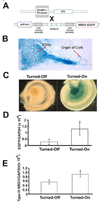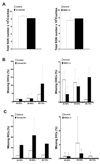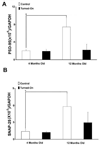Age-related neuronal loss in the cochlea is not delayed by synaptic modulation
- PMID: 20580130
- PMCID: PMC2947614
- DOI: 10.1016/j.neurobiolaging.2010.05.011
Age-related neuronal loss in the cochlea is not delayed by synaptic modulation
Abstract
Age-related synaptic change is associated with the functional decline of the nervous system. It is unknown whether this synaptic change is the cause or the consequence of neuronal cell loss. We have addressed this question by examining mice genetically engineered to over- or underexpress neuregulin-1 (NRG1), a direct modulator of synaptic transmission. Transgenic mice overexpressing NRG1 in spiral ganglion neurons (SGNs) showed improvements in hearing thresholds, whereas NRG1 -/+ mice show a complementary worsening of thresholds. However, no significant change in age-related loss of SGNs in either NRG1 -/+ mice or mice overexpressing NRG1 was observed, while a negative association between NRG1 expression level and survival of inner hair cells during aging was observed. Subsequent studies provided evidence that modulating NRG1 levels changes synaptic transmission between SGNs and hair cells. One of the most dramatic examples of this was the reversal of lower hearing thresholds by "turning-off" NRG1 overexpression. These data demonstrate for the first time that synaptic modulation is unable to prevent age-related neuronal loss in the cochlea.
Copyright © 2011 Elsevier Inc. All rights reserved.
Figures








Similar articles
-
Survival of adult spiral ganglion neurons requires erbB receptor signaling in the inner ear.J Neurosci. 2004 Oct 6;24(40):8651-61. doi: 10.1523/JNEUROSCI.0733-04.2004. J Neurosci. 2004. PMID: 15470130 Free PMC article.
-
The role of Efr3a in age-related hearing loss.Neuroscience. 2017 Jan 26;341:1-8. doi: 10.1016/j.neuroscience.2016.11.013. Epub 2016 Nov 17. Neuroscience. 2017. PMID: 27867060
-
Deterioration of the Medial Olivocochlear Efferent System Accelerates Age-Related Hearing Loss in Pax2-Isl1 Transgenic Mice.Mol Neurobiol. 2016 May;53(4):2368-83. doi: 10.1007/s12035-015-9215-1. Epub 2015 May 20. Mol Neurobiol. 2016. PMID: 25990412
-
No longer falling on deaf ears: mechanisms of degeneration and regeneration of cochlear ribbon synapses.Hear Res. 2015 Nov;329:1-10. doi: 10.1016/j.heares.2015.04.008. Epub 2015 Apr 30. Hear Res. 2015. PMID: 25937135 Free PMC article. Review.
-
The aging cochlea: Towards unraveling the functional contributions of strial dysfunction and synaptopathy.Hear Res. 2019 May;376:111-124. doi: 10.1016/j.heares.2019.02.015. Epub 2019 Mar 2. Hear Res. 2019. PMID: 30862414 Review.
Cited by
-
Why do hair cells and spiral ganglion neurons in the cochlea die during aging?Aging Dis. 2011 Jun;2(3):231-41. Epub 2011 Apr 28. Aging Dis. 2011. PMID: 22396875 Free PMC article.
-
Transcriptomic analysis highlights cochlear inflammation associated with age-related hearing loss in C57BL/6 mice using next generation sequencing.PeerJ. 2020 Aug 19;8:e9737. doi: 10.7717/peerj.9737. eCollection 2020. PeerJ. 2020. PMID: 32879802 Free PMC article.
-
Recent advances in the study of age-related hearing loss: a mini-review.Gerontology. 2012;58(6):490-6. doi: 10.1159/000338588. Epub 2012 Jun 15. Gerontology. 2012. PMID: 22710288 Free PMC article. Review.
-
Integrating pharmacogenomics into clinical trials of hearing disorders.J Acoust Soc Am. 2022 Nov;152(5):2828. doi: 10.1121/10.0015092. J Acoust Soc Am. 2022. PMID: 36456290 Free PMC article.
-
Effect of neuregulin-1 on the auditory cortex in adult C57BL/6J mice.Iran J Basic Med Sci. 2020 Mar;23(3):362-367. doi: 10.22038/IJBMS.2020.33656.8026. Iran J Basic Med Sci. 2020. PMID: 32440323 Free PMC article.
References
-
- Adlkofer K, Lai C. Role of neuregulins in glial cell development. Glia. 2000;29:104–111. - PubMed
-
- Bao J. Signal transduction by the cytoplasmic domain of Neuregulin-1 and its roles in neuronal aging. Curr. Signal. Trans. Therapy. 2007;2:240–245.
-
- Bao J, Lin H, Ouyang Y, Lei D, Osman A, Kim TW, Mei L, Dai P, Ohlemiller KK, Ambron RT. Activity-dependent transcription regulation of PSD-95 by neuregulin-1 and Eos. Nat. Neurosci. 2004;7:1250–1258. - PubMed
Publication types
MeSH terms
Substances
Grants and funding
LinkOut - more resources
Full Text Sources
Other Literature Sources
Medical
Molecular Biology Databases

